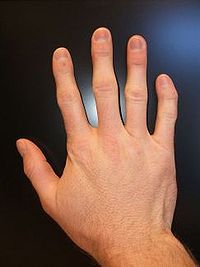Difference between pages "Translations:Adventist Youth Honors Answer Book/Nature/Animal Tracking/71/en" and "Translations:Adventist Youth Honors Answer Book/Health and Science/Heredity/19/en"
From Pathfinder Wiki
(Difference between pages)
(Importing a new version from external source) |
(Importing a new version from external source) |
||
| Line 1: | Line 1: | ||
| − | + | ;Bent pinky: Holding your hand up in front of you, palm outwards, fingers extended you will notice that your pinky finger may or may not bend towards your ring finger. This is called Clinodactyly (from the Ancient Greek klinen meaning "to bend" and daktylos meaning "digit"). It could be seen in (a finger or toe) but is most commonly seen in the fifth finger (the "little finger") towards the adjacent fourth finger (the "ring finger"). It is a harmless anomily, but is associated with many genetic syndromes. Between 1%-19.5% of a given population will have Clinodactyly. [[Image:Sampleclinodactyly.jpg|left|200px]]. | |
Latest revision as of 00:16, 9 January 2021
- Bent pinky
- Holding your hand up in front of you, palm outwards, fingers extended you will notice that your pinky finger may or may not bend towards your ring finger. This is called Clinodactyly (from the Ancient Greek klinen meaning "to bend" and daktylos meaning "digit"). It could be seen in (a finger or toe) but is most commonly seen in the fifth finger (the "little finger") towards the adjacent fourth finger (the "ring finger"). It is a harmless anomily, but is associated with many genetic syndromes. Between 1%-19.5% of a given population will have Clinodactyly. .

